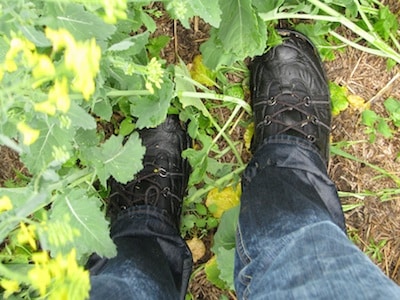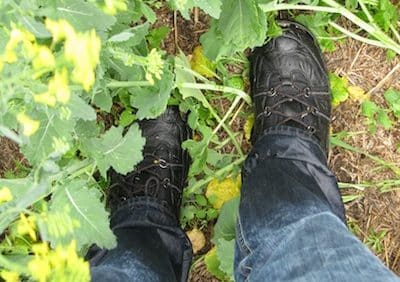
When it comes to the sclerotinia stem rot risk, moisture has a much larger influence than temperatures. Infection can be high in hot weather as long as the moisture is there. Moisture can come from rain, relative humidity in the high 80s, or morning dew. High humidity and dew are often enough for sclerotinia fungus to produce the hyphae that release oxalic acid allowing the fungus to invade healthy plant tissue and infect the plant. Night and morning lows of 15 C are perfect, especially with heavy dew. Infection may not advance during the heat of the day, but it will grow at night.
Hot days can reduce sclerotinia stem rot infection rates if heat causes infected petals to dry up and blow off the plant. Heat may also cause canola plants to drop lower leaves at an accelerated pace. If infected leaves drop before infection spreads to the stem, the heat will have indirectly stopped the infection.
Comments on…
Humidity readings. Humidity is often higher in the canola canopy than at the local weather station or in the farm yard, so consider this when estimating disease risk.
This year versus last year. Last year much of the Prairie, especially the Western Prairie, had heavy rains at flowering. Heavy and frequent rains can inhibit ascospore release by covering up apothecia, and can wash petals off the plants. So far we have not seen widespread regular heavy rains during the flowering period of our earlier crops.
Thin stands not immune. Kelly Turkington in his webinar two weeks ago said canola with yield potential below 25-30 bushels per acre may not benefit from a spray. But in general, growers can’t bank on wider row spacing and low seeding rates to reduce risk. Any risk reduction from these strategies requires the weather conditions to cooperate. If winds move dry air through the canopy and keep the crop dry for much of the day, then a more open canopy may be beneficial. But if wet conditions predominate throughout flowering, then any risk reduction will be minimal. And once plants are infected, a few hours of hot and dry each afternoon may stop the pathogen for a short part of the day, but it will restart again in evening with cool humid conditions.
Is a risk assessment score of 30 enough to justify a spray? The risk assessment score card developed in Sweden says a spray will likely pay with a score of 40 or more. But canola prices are higher and fungicide prices are lower than when this was developed, so a score of 30 to 35 might be a better starting point. When filling in the card, everyone should probably score at least a 5 for rotation risk given the large canola acreage in recent years. Even if one farm has a 1 in 4 canola rotation, odds are some fields close by are in a tighter rotation, meaning nobody is immune to sclerotinia risk if the conditions are right. While most spores will end up within 100m of where they were produced, some can become airborne and transport to neighbouring fields. Apothecia can germinate anywhere at high enough numbers to cause severe infection in any field — as long as the moisture is there.
Canola advances quickly. Growers planning a fungicide spray may be surprised how quickly canola reaches 20-30% flower and then advances quickly to 50% flower — the end of the fungicide window. What about spraying after 50% flower? Late applications are not on fungicide labels, and may be inside the preharvest interval for some fungicides. Also, late applications are not as effective. The main stem flowers first, and these flowers are more likely to drop on main leaves and against the main stem, leading to infection that girdles the main stem. And earlier infections have more time to develop and cause more damage to the plant. After 50% flower, most of the flowering is on side branches. These petals tend to drop onto upper leaves and side branches, causing minimal damage to the main stem.
Click here to watch an archived version of Kelly Turkington’s webinar on sclerotinia risk assessment.
